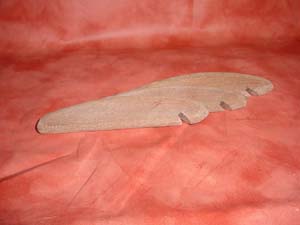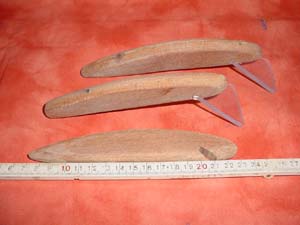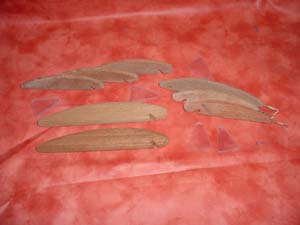


It doesn't always go as planned.
I meant to build some copies of the Grandma with a length of 15 cm. Because that is the size on which I caught several nice fish during the months of October and November. Used during fishing in canals with a maximum depth of 2 meters. When I expect mostly pike, I choose a twitchbait that dives down to about 1m. For walleye take a crankbait that touches the bottom now and then. That's why I always take different lures with different depthranges with me. Because I fish from the shore I try not to exagerate and try to limit the amount of lures I take with me.
We built these lures ourselves. After some experience you know which characteristics the lip needs to have. With characteristics I mean the size of the lip and the angle of the lip on to the lure. Even the weighting of the lure plays a big part. Are you going to weight the lure so it sits horizontally in the water or do you prefer that the lure hangs head down in the water? With that last lure you can fish very deep most of the times.
 But for now the Grandma 15 cm is the first one on our list. From two beams of meranti wood I sawed boards with a thickness of 13 mm (using an electrical saw). With a marker I drew the lures on the wood, using a stencil. Because the design is very simple, without sharp bends, it is ideal to saw out with an electrical saw. From the middle up to the tail I use a sanding machine to sand the shape of the lure so that the tail is thinner than the rest of the lurebody. This provides a better action. After some filing and sanding, the edges are nicely rounded and the lure's shape is ready. The slot for the lip is sawed with a hacksaw in combination with a mitre-box. Because it all seems to go so easy and smooth I decide to build two versions: one with a length of 23 cm and one with a length of 19 cm. These are 18 mm thick and they are perfect for trolling.
But for now the Grandma 15 cm is the first one on our list. From two beams of meranti wood I sawed boards with a thickness of 13 mm (using an electrical saw). With a marker I drew the lures on the wood, using a stencil. Because the design is very simple, without sharp bends, it is ideal to saw out with an electrical saw. From the middle up to the tail I use a sanding machine to sand the shape of the lure so that the tail is thinner than the rest of the lurebody. This provides a better action. After some filing and sanding, the edges are nicely rounded and the lure's shape is ready. The slot for the lip is sawed with a hacksaw in combination with a mitre-box. Because it all seems to go so easy and smooth I decide to build two versions: one with a length of 23 cm and one with a length of 19 cm. These are 18 mm thick and they are perfect for trolling.
 Then I drilled the holes for the screw-eyes. I attached the lip with a wedge as well. Now it was time for the exact weighting. But when I dropped the lures in the water, they sank like a brick. Even without the lip and the screw-eyes. Wrong, all that hard work for nothing. The strange thing is that the lures that where sawed out of the other board didn't sink. They floated nicely. I can build something nice from those. Thank God the bigger Grandma's don't have this problem. I'm still going to prime the misfits just to see if I can do something with them. Maybe I can rebuild them into jerkbaits.
Then I drilled the holes for the screw-eyes. I attached the lip with a wedge as well. Now it was time for the exact weighting. But when I dropped the lures in the water, they sank like a brick. Even without the lip and the screw-eyes. Wrong, all that hard work for nothing. The strange thing is that the lures that where sawed out of the other board didn't sink. They floated nicely. I can build something nice from those. Thank God the bigger Grandma's don't have this problem. I'm still going to prime the misfits just to see if I can do something with them. Maybe I can rebuild them into jerkbaits.
I could have prevented this problem by using a different kind of wood, for example red cedar. This wood has a much better buoyancy than meranti and therefore it is easier to manipulate. The disadvantage is that it is not as hard as meranti. You have to realize that you have to deal with this kind of setbacks when you build your own lures. With this article I have tried to show you that the road of a lurebuilder doesn't always goes as planned. Hopefully by reading this article you will be inspired not to quit when things don't happen as you hoped for.
Klaas-Jan Zuidema.



 But for now the Grandma 15 cm is the first one on our list. From two beams of meranti wood I sawed boards with a thickness of 13 mm (using an electrical saw). With a marker I drew the lures on the wood, using a stencil. Because the design is very simple, without sharp bends, it is ideal to saw out with an electrical saw. From the middle up to the tail I use a sanding machine to sand the shape of the lure so that the tail is thinner than the rest of the lurebody. This provides a better action. After some filing and sanding, the edges are nicely rounded and the lure's shape is ready. The slot for the lip is sawed with a hacksaw in combination with a mitre-box. Because it all seems to go so easy and smooth I decide to build two versions: one with a length of 23 cm and one with a length of 19 cm. These are 18 mm thick and they are perfect for trolling.
But for now the Grandma 15 cm is the first one on our list. From two beams of meranti wood I sawed boards with a thickness of 13 mm (using an electrical saw). With a marker I drew the lures on the wood, using a stencil. Because the design is very simple, without sharp bends, it is ideal to saw out with an electrical saw. From the middle up to the tail I use a sanding machine to sand the shape of the lure so that the tail is thinner than the rest of the lurebody. This provides a better action. After some filing and sanding, the edges are nicely rounded and the lure's shape is ready. The slot for the lip is sawed with a hacksaw in combination with a mitre-box. Because it all seems to go so easy and smooth I decide to build two versions: one with a length of 23 cm and one with a length of 19 cm. These are 18 mm thick and they are perfect for trolling.
 Then I drilled the holes for the screw-eyes. I attached the lip with a wedge as well. Now it was time for the exact weighting. But when I dropped the lures in the water, they sank like a brick. Even without the lip and the screw-eyes. Wrong, all that hard work for nothing. The strange thing is that the lures that where sawed out of the other board didn't sink. They floated nicely. I can build something nice from those. Thank God the bigger Grandma's don't have this problem. I'm still going to prime the misfits just to see if I can do something with them. Maybe I can rebuild them into jerkbaits.
Then I drilled the holes for the screw-eyes. I attached the lip with a wedge as well. Now it was time for the exact weighting. But when I dropped the lures in the water, they sank like a brick. Even without the lip and the screw-eyes. Wrong, all that hard work for nothing. The strange thing is that the lures that where sawed out of the other board didn't sink. They floated nicely. I can build something nice from those. Thank God the bigger Grandma's don't have this problem. I'm still going to prime the misfits just to see if I can do something with them. Maybe I can rebuild them into jerkbaits.